1. Labor market, definition of human



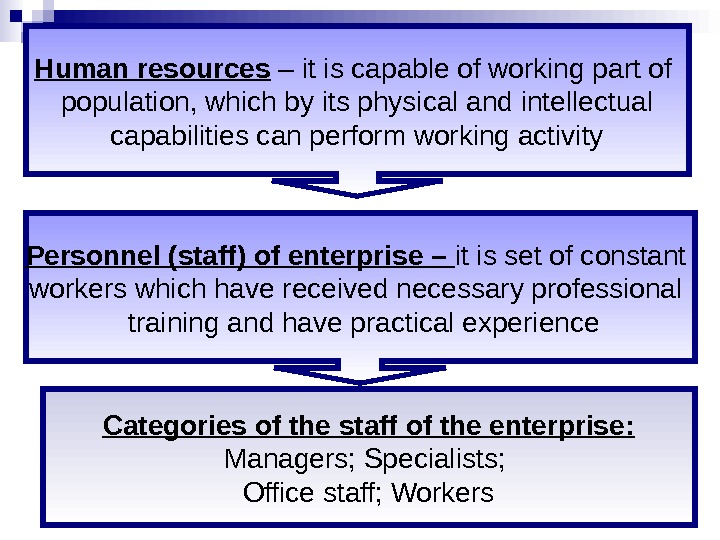
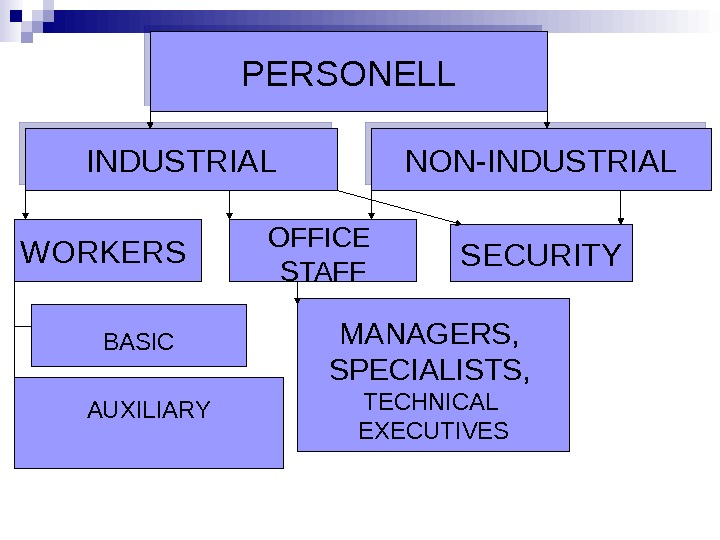












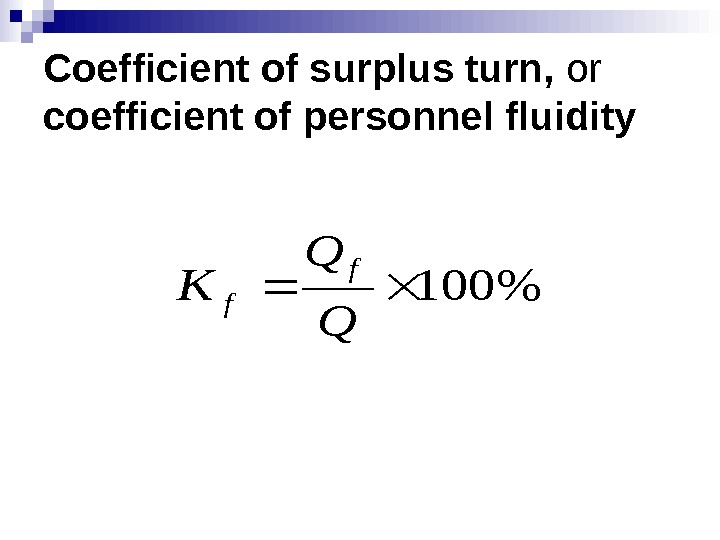
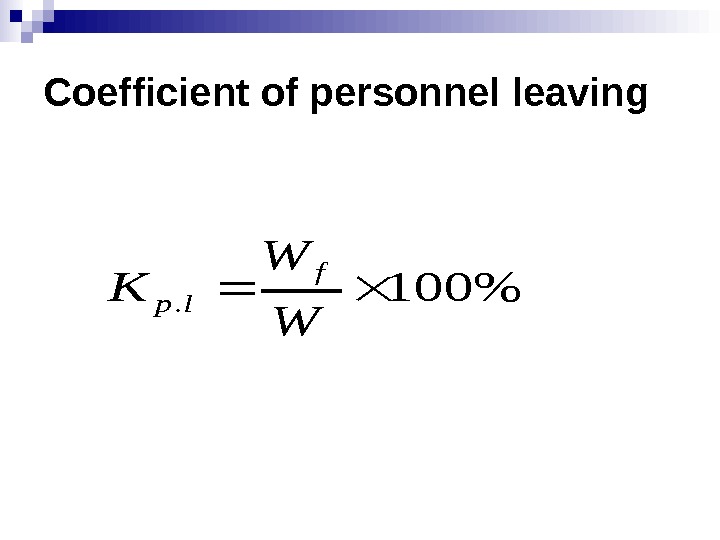







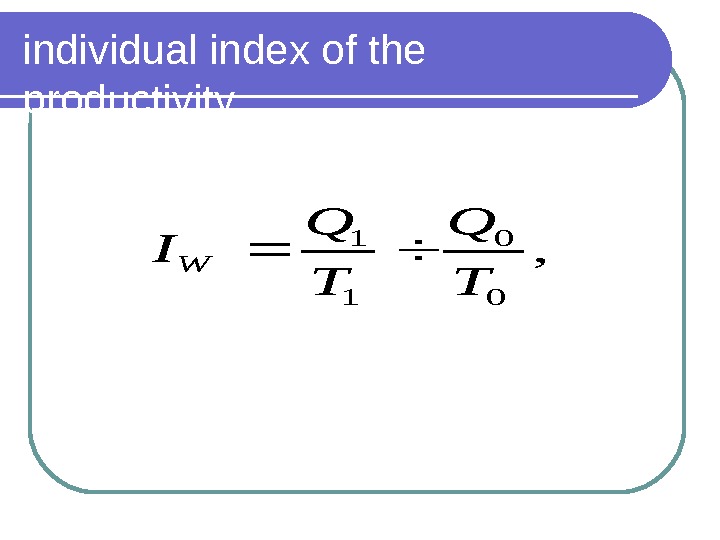

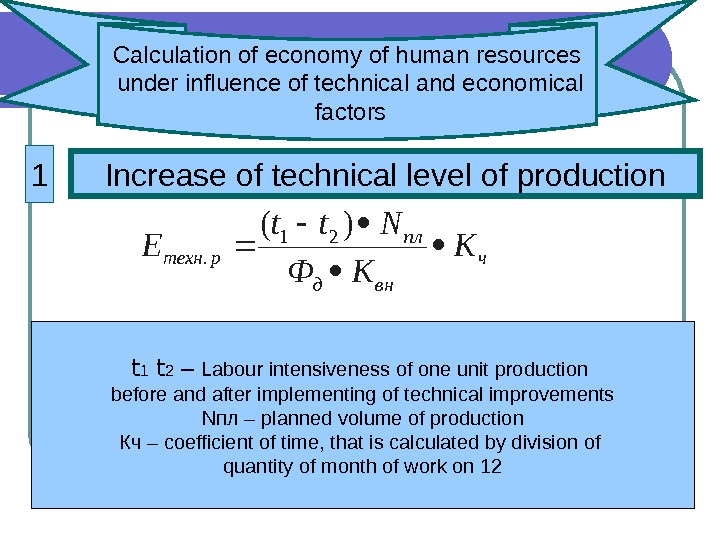


















- Размер: 312 Кб
- Количество слайдов: 46
Описание презентации 1. Labor market, definition of human по слайдам
 1. Labor market, definition of human resources 2. The planning of human resources 3. Productivity and motivation of labor 4. Wages as payment of labor on enterprise
1. Labor market, definition of human resources 2. The planning of human resources 3. Productivity and motivation of labor 4. Wages as payment of labor on enterprise
 Types of unemployment Natural Forced Frictional Voluntary Institutional Structural Technological Regional Hidden
Types of unemployment Natural Forced Frictional Voluntary Institutional Structural Technological Regional Hidden
 Human resources – it is capable of working part of population, which by its physical and intellectual capabilities can perform working activity Personnel (staff) of enterprise – it is set of constant workers which have received necessary professional training and have practical experience Categories of the staff of the enterprise : Managers ; Specialists ; Office staff; Workers
Human resources – it is capable of working part of population, which by its physical and intellectual capabilities can perform working activity Personnel (staff) of enterprise – it is set of constant workers which have received necessary professional training and have practical experience Categories of the staff of the enterprise : Managers ; Specialists ; Office staff; Workers
 PERSONELL INDUSTRIAL NON-INDUSTRIAL WORKERS OFFICE STAFF SECURITY BASIC AUXILIARY MANAGERS , SPECIALISTS , TECHNICAL EXECUTIVES
PERSONELL INDUSTRIAL NON-INDUSTRIAL WORKERS OFFICE STAFF SECURITY BASIC AUXILIARY MANAGERS , SPECIALISTS , TECHNICAL EXECUTIVES
 Classification of personnel 1. According to the character of participating in the enterprise activity industrial Non-industrial 2. According to the functions Workers, office staff , managers , specialists , 3. According to the professions and specialization
Classification of personnel 1. According to the character of participating in the enterprise activity industrial Non-industrial 2. According to the functions Workers, office staff , managers , specialists , 3. According to the professions and specialization
 Trade — the kind of activity demanding certain knowledge and labor skills which are got by the general or the professional education and practical experience Speciality — a kind of activity within the limits of particular trade which has specific features and demands from workers of additional special knowledge and skills.
Trade — the kind of activity demanding certain knowledge and labor skills which are got by the general or the professional education and practical experience Speciality — a kind of activity within the limits of particular trade which has specific features and demands from workers of additional special knowledge and skills.
 4. According to qualification Workers : Highly qualified Qualified Low qualified Non qualified Office workers : The highest category Upper intermediate Intermediate Practical. Qualification defines level of knowledge and labor skills of the worker on a speciality which is displayed in qualifying (tariff) categories and categories.
4. According to qualification Workers : Highly qualified Qualified Low qualified Non qualified Office workers : The highest category Upper intermediate Intermediate Practical. Qualification defines level of knowledge and labor skills of the worker on a speciality which is displayed in qualifying (tariff) categories and categories.
 5. According to age and sex Man ( up to 30 years ; from 30 to 60 ; more than 60 ) Woman ( up to 30 years ; from 30 to 60 ; more than 60 ) 6. According to years of work on the enterprise Up to 1 year 1 -3 years 3 -10 years More than 10 years
5. According to age and sex Man ( up to 30 years ; from 30 to 60 ; more than 60 ) Woman ( up to 30 years ; from 30 to 60 ; more than 60 ) 6. According to years of work on the enterprise Up to 1 year 1 -3 years 3 -10 years More than 10 years
 Planning of human resources 1. Evaluatio n of current human resources 2. Evaluation of future need for human resources 3. Development of the program of the growth of human resources
Planning of human resources 1. Evaluatio n of current human resources 2. Evaluation of future need for human resources 3. Development of the program of the growth of human resources
 Selection of staff Interview Testing Training centers
Selection of staff Interview Testing Training centers
 Measures on selecting of human resources: 1. To find out, what categories of labor force must be picked up 2. Making a decision about forming necessary personnel 3. Selection of personnel
Measures on selecting of human resources: 1. To find out, what categories of labor force must be picked up 2. Making a decision about forming necessary personnel 3. Selection of personnel
 Functions of employment 1. Informational 2. Motivational 3. First-stage selection
Functions of employment 1. Informational 2. Motivational 3. First-stage selection
 Methods of employment Passive Active Non-direct forms Direct forms
Methods of employment Passive Active Non-direct forms Direct forms
 Indexes of description of personnel 1. By number: — registration; on call; average quantity 2. By Quality : economic; personality; organizationally technical 3. Structural
Indexes of description of personnel 1. By number: — registration; on call; average quantity 2. By Quality : economic; personality; organizationally technical 3. Structural
 Fund of human resources Fhr = Qav х Т wp Qav – average number of employees Twp – average duration of working period
Fund of human resources Fhr = Qav х Т wp Qav – average number of employees Twp – average duration of working period
 Indexes of presence of labour force and its motion Coefficient of necessary turn %100. F F К nt nt Fnt – fired on production reasons F- all fired personnel
Indexes of presence of labour force and its motion Coefficient of necessary turn %100. F F К nt nt Fnt – fired on production reasons F- all fired personnel
 Coefficient of surplus turn, or coefficient of personnel fluidity%100 Q Q К f f
Coefficient of surplus turn, or coefficient of personnel fluidity%100 Q Q К f f
 Coefficient of personnel leaving%100. W W К f lp
Coefficient of personnel leaving%100. W W К f lp
 Coefficient of personnel employed%100 W W К e e
Coefficient of personnel employed%100 W W К e e
 Level of usage of working day , Тn Т К f us Т f – average actual duration of working day in hours ; Т n – normative duration of working day in hours
Level of usage of working day , Тn Т К f us Т f – average actual duration of working day in hours ; Т n – normative duration of working day in hours
 Calculation of the necessary quantity of workerscnwp planned КТ t Q t – time of production Twp – normative time for work performance Kcn – coefficient for completing the planned parameters
Calculation of the necessary quantity of workerscnwp planned КТ t Q t – time of production Twp – normative time for work performance Kcn – coefficient for completing the planned parameters
 Norms of work: 1. Norm of time Nt = Tos +Tdop+Tob+Tv 2. A norm of production: Np = Td/Nt 3. Norm of service Nob = Td/Tob
Norms of work: 1. Norm of time Nt = Tos +Tdop+Tob+Tv 2. A norm of production: Np = Td/Nt 3. Norm of service Nob = Td/Tob
 Methods of measurement direct reverse productivity of work ( В ) = Volume of products Quantity of workers Labor intensiveness (Тр)= Quantity of workers Volume of products
Methods of measurement direct reverse productivity of work ( В ) = Volume of products Quantity of workers Labor intensiveness (Тр)= Quantity of workers Volume of products
 , ; Q t Т Ч Q B р сп
, ; Q t Т Ч Q B р сп
 Methods of measurement of work productivity Natural method Cost method Work method
Methods of measurement of work productivity Natural method Cost method Work method
 individual index of the productivity , 0 0 1 1 T Q I W
individual index of the productivity , 0 0 1 1 T Q I W
 Index of the productivity of seasonal staff. 0 0 1 1 Т Q T Q I пер
Index of the productivity of seasonal staff. 0 0 1 1 Т Q T Q I пер
 Calculation of economy of human resources under influence of technical and economical factors 1 Increase of technical level of production t 1 t 2 – Labour intensiveness of one unit production before and after implementing of technical improvements N пл – planned volume of production Кч – coefficient of time , that is calculated by division of quantity of month of work on 12 ч внд пл ртехн. К КФ Ntt Е )(21.
Calculation of economy of human resources under influence of technical and economical factors 1 Increase of technical level of production t 1 t 2 – Labour intensiveness of one unit production before and after implementing of technical improvements N пл – planned volume of production Кч – coefficient of time , that is calculated by division of quantity of month of work on 12 ч внд пл ртехн. К КФ Ntt Е )(21.
 2 Structural changes in productionвнд плплб зрстр КФ QТТ Е )(. Тб Тпл — labor intensiveness in finished product 3 Improvement of management in the organization of production and work норбупрусов. ЧСЧСЕ. ЧС — total quantity of managers, specialists, office workers
2 Structural changes in productionвнд плплб зрстр КФ QТТ Е )(. Тб Тпл — labor intensiveness in finished product 3 Improvement of management in the organization of production and work норбупрусов. ЧСЧСЕ. ЧС — total quantity of managers, specialists, office workers
 4 Improvement of work time usageроб. ПВП б бпл чроб. ПЧ Д ДД Е . Д – average number of days worked by 1 employee Ч ПВП – number of industrial personnel, corrected on the influence of structure changes factors П роб – percent of employee in basic number of industrial personnel
4 Improvement of work time usageроб. ПВП б бпл чроб. ПЧ Д ДД Е . Д – average number of days worked by 1 employee Ч ПВП – number of industrial personnel, corrected on the influence of structure changes factors П роб – percent of employee in basic number of industrial personnel
 5 Change of production volume 100/. . пост. Чус. Qпостус. Чбпр. Еоб Ч б. ум-пост – basic number of conditionally-constant industrial personnel Q – gain of production volumes , % Ч ум-пост – gain of number of conditionally- constant industrial personnel , %Relative decrease of workers number altogether with increase of production volume
5 Change of production volume 100/. . пост. Чус. Qпостус. Чбпр. Еоб Ч б. ум-пост – basic number of conditionally-constant industrial personnel Q – gain of production volumes , % Ч ум-пост – gain of number of conditionally- constant industrial personnel , %Relative decrease of workers number altogether with increase of production volume
 7 Branch factors Relative economy of labor on this group of factors пл пл плб Ф tt ф. Еотр . t б , t пл – labor input of unit of production in basic and planned production conditions , norm hours ; Nпл – planned volume of production , natural items Фпл – planned fund of working time of one employee, hours
7 Branch factors Relative economy of labor on this group of factors пл пл плб Ф tt ф. Еотр . t б , t пл – labor input of unit of production in basic and planned production conditions , norm hours ; Nпл – planned volume of production , natural items Фпл – planned fund of working time of one employee, hours
 6 Average number of personnel Calculated as: P 1. . 12 – month number of employees 12 2 1. . . 2 1 121121 _PPPP P
6 Average number of personnel Calculated as: P 1. . 12 – month number of employees 12 2 1. . . 2 1 121121 _PPPP P
 8 Gain of work productivity 100. Еобщ. Чвих Еобщ пл. Пп 100 Ко. Чбаз Чвих – number of industrial personnel in planned period, persons Ко – rate of growth of production volumes in planned period, % Еобщ – total economy on number of personnel
8 Gain of work productivity 100. Еобщ. Чвих Еобщ пл. Пп 100 Ко. Чбаз Чвих – number of industrial personnel in planned period, persons Ко – rate of growth of production volumes in planned period, % Еобщ – total economy on number of personnel
 9 Change of labor productivity as result of change in the labour intensiveness of production program 100 Тпрог Пп 100. . б. Тпрог час. Ероб Тпрогр Пп – possible increase or decrease of labor productivity in basic period , % Тпргр – percent of increase or decrease of labor intensiveness of production program in basic period Ероб. час – economy on working time expenditures on execution of production program in basic period , norm hours. Тпрогр. б – labour intensiveness of production program in basic period , norm hours.
9 Change of labor productivity as result of change in the labour intensiveness of production program 100 Тпрог Пп 100. . б. Тпрог час. Ероб Тпрогр Пп – possible increase or decrease of labor productivity in basic period , % Тпргр – percent of increase or decrease of labor intensiveness of production program in basic period Ероб. час – economy on working time expenditures on execution of production program in basic period , norm hours. Тпрогр. б – labour intensiveness of production program in basic period , norm hours.
 10 Production gain on increase of work productivity 100100 Q Ч Qпп Ч – gain of personnel number , % Q – gain of production volume , %
10 Production gain on increase of work productivity 100100 Q Ч Qпп Ч – gain of personnel number , % Q – gain of production volume , %
 4 Wages are a size of the monetary compensation paid to the hired worker for performance of the certain task, amount of works or execution of the official duties during appointed time
4 Wages are a size of the monetary compensation paid to the hired worker for performance of the certain task, amount of works or execution of the official duties during appointed time
 Types of wages Nominal Real Ірзп = Інзп/Іц Ірзп – index of real wage Інзп – index of nominal wage Іц – price index
Types of wages Nominal Real Ірзп = Інзп/Іц Ірзп – index of real wage Інзп – index of nominal wage Іц – price index
 Functions of wage Restoration Stimulation Regulation Social
Functions of wage Restoration Stimulation Regulation Social
 FORM OF WAGES HOURLY PAYMENT PRICE-WORK PAYMENT
FORM OF WAGES HOURLY PAYMENT PRICE-WORK PAYMENT
 HOURLY WAGE Simple time wage Зп. п = Фм*С Фм – quantity of fulfilled time С – tariff rate of the worker , hrn Time and premium wage Зп. прем = Зпп+ P P — premium
HOURLY WAGE Simple time wage Зп. п = Фм*С Фм – quantity of fulfilled time С – tariff rate of the worker , hrn Time and premium wage Зп. прем = Зпп+ P P — premium
 Per item payment — direct З d = NPi n i * 1 Рі = Тшт*С Pi = Нв Cч Р i – price-work price for production of one item N – quantity of actually produced items by one employee Тшт – time of production of one item C – cost of time according to tariff H в – norm of production
Per item payment — direct З d = NPi n i * 1 Рі = Тшт*С Pi = Нв Cч Р i – price-work price for production of one item N – quantity of actually produced items by one employee Тшт – time of production of one item C – cost of time according to tariff H в – norm of production
 Time and premium per item payment З tp = З tar + P З tar – payment by tariff of employee within direct price-work system
Time and premium per item payment З tp = З tar + P З tar – payment by tariff of employee within direct price-work system
 Progressive system: payment for work is within the norm paid for the basic price-work quotations, and its excess — on raised. Зс. прог = Nвих * Р Д + (Nф — Nвих) * Рпов Nвих – number of produced items within set norm of production Р Д — basic tariff N ф — number of actually produced items Рпов – raised tariff for excess volume of production
Progressive system: payment for work is within the norm paid for the basic price-work quotations, and its excess — on raised. Зс. прог = Nвих * Р Д + (Nф — Nвих) * Рпов Nвих – number of produced items within set norm of production Р Д — basic tariff N ф — number of actually produced items Рпов – raised tariff for excess volume of production
 Indirect p er item payment : is applied as payment for the auxiliary workers serving the basic workers. Size of wage of this workers depends on rate and productivity of the basic workers. Зпод = (Nфі * Рсі)/ n Рсі = Nпплn Cсм * Рсі – indirect price-work payment n – number of workers in basic production , served by auxiliary worker N пп – volume of production, produced by basic workers Ссм – shift tariff of auxiliary worker
Indirect p er item payment : is applied as payment for the auxiliary workers serving the basic workers. Size of wage of this workers depends on rate and productivity of the basic workers. Зпод = (Nфі * Рсі)/ n Рсі = Nпплn Cсм * Рсі – indirect price-work payment n – number of workers in basic production , served by auxiliary worker N пп – volume of production, produced by basic workers Ссм – shift tariff of auxiliary worker
 Earning of the auxiliary worker is calculated: Звсп = Тф *С *Квн Тф – actually worked time by auxiliary worker С – hourly tariff rate of the auxiliary worker Квн – average coefficient of norm fulfilling on area, which is served by auxiliary worker
Earning of the auxiliary worker is calculated: Звсп = Тф *С *Квн Тф – actually worked time by auxiliary worker С – hourly tariff rate of the auxiliary worker Квн – average coefficient of norm fulfilling on area, which is served by auxiliary worker

